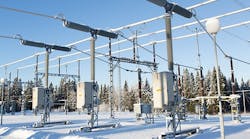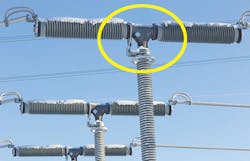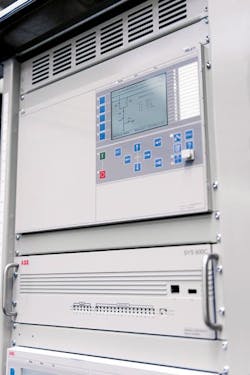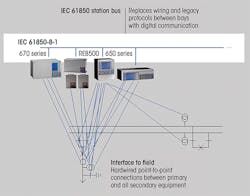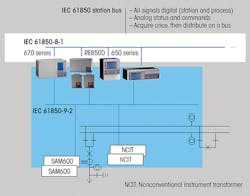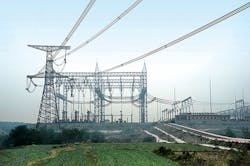The world has gone digital and that includes the electricity industry. It is hard to remember the time when relays were simple electromechanical devices without firmware, communications interfaces or multifunctionality. Providing electricity has always been challenging, but new technologies increased the complexity of that challenge when moving from the 20th century to the 21st century. The industry had to bridge the gap between aging analog devices and digital technologies.
Today, there is not a single component in a substation that has not been enhanced, enriched or augmented by some form of embedded digital technology, making them operate better at higher ratings with more reliability than ever before. However, the challenge now is integrating all of these elements into a totally digital substation and making it work in a demanding environment.
Several issues are pushing the digitalization of the electrical substation. The grid is operating mainly at maximum capacity in much of the developed world as customers demand more power and better power quality. Therefore, when a fault takes place, it must be cleared as quickly as possible, which is where modern digital technology offers so many benefits. On the customer side of the meter, digital technology is being integrated into the Internet of Things (IoT). In a nutshell, IoT is a network of devices, buildings, vehicles and just about every other type of physical object one can think of equipped with sensors, connected by networks, and monitored and controlled by computer-based systems.
Smart Is Not New
With IoT, people can check the security of their homes from hundreds of miles, or kilometers, away. Home thermostats can be adjusted from any location by pulling up an app on a smartphone. Luggage can be tracked with another app when the airline says it cannot locate a missing suitcase. Cars even e-mail their owners when they need maintenance. And IoT has taken this connectivity to a level of being able to add sensors on people and monitor them with wired workout clothes and devices like a Fitbit fitness tracker.
This level of connectivity also has found its way into substations and switching stations, as utilities integrate more equipment with interconnectivity capability. The digital substation concept has been grabbing a lot of traction with utilities around the world, but one should know digital technology is not a new concept to the electric power industry. Utilities have been digitizing their facilities in one form or another for decades. In the period after World War II, transmission systems experienced an unparalleled growth period as demand for electricity increased. Visionaries saw a need for new technologies to play a bigger role in how the grid was controlled and managed.
Long before there was a smart grid, the electric power industry had a stratagem of an all-knowing grid with technology-enabled substations networked into a communicating transmission and distribution grid. The nomenclature may have been different, but the idea had smart grid written all over it; the technology just needed time to develop. The industry deployed supervisory control and data acquisition (SCADA) and then remote terminal units (RTUs) were introduced. These were followed by the introduction of micro-processor-based relays for control and protection systems.
Technology moved forward and communications interfaces were integrated directly into the microprocessor-based relays. Advancements in the microprocessor’s firmware and software brought about multifunctional microprocessor-based relays that communicated directly with RTUs and gateways.
All of these innovations ramped up the complicatedness, but they also increased system performance enormously. During about the same time frame, vendors began incorporating intelligent electronic device (IED) technology into the electrical apparatus and components found throughout the substation, including the switchyard. As a result, the industry experienced a transformation more far-reaching than any in the past. Not only was the industry exploiting digital technology, but it was setting the stage for incorporating IoT technology into the grid.
Digital technologies are driving the evolution of digital substations. This FOCS is smaller than conventional current transformers. It also provides direct digital measurements and doesn’t use copper cable to take data into the control building.
New devices make up smarter grid technology with better communications, modern computer technology and more intelligent automation devices.
Standards Are the Key
There was one small problem initially — proprietary equipment. Each of the systems and all of their components were exclusive and protected by patents and copyrights. In other words, one manufacturer’s system did not play well with another manufacturer’s system (that is, they could not communicate).
At best, communications between the different manufacturers’ schemes was piecemeal and fragmented. One might say they were mutually incompatible and kept that way with an assortment of nonstandard messaging protocols. It was the technological equivalent to the Tower of Babel. Luckily, it did not take a rocket scientist to see the problem proprietary systems caused. As a result, open standards became the solution.
In 1995, the International Electrotechnical Commission (IEC) began working on IEC 61850, a communications standard published in 2003 for electrical substation automation systems. Today, this document has many parts that relate to data modeling, reporting schemes, fast event transfers, setting groups, sample date transfer, commands and data storage that create a uniform basis for the protection, control and communications of substations. A short time after IEC 61850 was accepted, IEC 61850-9-1 (a point-to-point unidirectional process bus) was introduced.
By 2005, the world’s first IEC 61850-based substation was commissioned in Switzerland. It was the Winznauschachen substation owned by Swiss distribution network operator Atel Versorgungs AG, part of the Aare-Tessin AG Group, an independent power producer. The Swiss substation was transformed into a substation with an IEC 61850-based protection and control system that included several IEDs to improve control and feedback.
Today’s conventional substation design may include digital technology, but it doesn’t take advantage of the technology’s potential. Courtesy of ABB.
A truly digital substation uses state of the art intelligent digital technologies, digital messaging systems, process bus and data management. Courtesy of ABB.
Smarter Substations
More than 100 substations were installed worldwide by 2007, all claiming to be operating with IEC 61850-based equipment, but utilities had a new concern. Industry-wise, IEC 61850 had been developed, but no one had tested the interchangeability of intelligent devices from multiple manufacturers. But what happens if you mix and match components and systems from different suppliers?
This was the question Comisión Federal de Electricidad (CFE) in Mexico wanted answered. Suppliers had been diligent about getting their equipment certified to be in compliance with IEC 61850, but none of the manufacturers were working together for group certification.
CFE decided IEC 61850 interoperability needed actual field testing in an operating substation, which is reasonable because the substation is a melting pot of technologies. CFE reasoned the best lab was its transmission grid, so the utility turned its 230-kV La Venta Wind Park substation — located in Juchitán, Oaxaca, Mexico — into a test bed for this interchangeability. CFE brought together six manufacturers — RUGGEDCOM, Schweitzer Engineering Laboratories, GE Energy, Siemens, ZIV and Team Arteche — using nine product platforms for the second phase of the substation expansion.
It was the acid test to see if components from multiple suppliers built to the IEC 61850 standard could actually be plug and play. Well, it worked. CFE’s experiment at the La Venta substation became the world’s first IEC 61850-based substation using multiple manufacturers to be placed in service on a utility’s transmission grid. Interoperability was no longer a cerebral notion but an actual field-proven fact, and the industry was one step closer to the reality of a totally digital substation. Proving this plug-and-play feature was a huge step forward.
China is integrating next-generation smart substation technology, according to the State Grid China Corp. The project uses state-of-the-art software and power technology to enable remote control, protection, automation, monitoring and diagnostics for these substations, as well as to allow both a reduction in their operating costs and footprint. Courtesy of ABB.
The Digital Divide
What exactly is a digital substation? It sounds like they have been built for a long time now. Substations have had many digital devices integrated into their infrastructure, but what the industry has today is a hybrid of analog and digital technologies. The purely analog substation is hard to find and definitely on the endangered species list, but the totally digital substation has not completely emerged, either. The definition of the digital substation is a moving target because technology is changing so quickly.
Technical providers talk about levels, hierarchies or architectures to describe a digital substation. Whatever their name, they are usually broken down into general terms such as a communications element, a control and protection function, and a process portion. Sometimes the components are found in several levels, and this gets a little confusing. For the purpose of this discussion, the focus will be more on the function than the form.
The one element that has the most consistent definition among the experts is the communications level, which, by the way, is probably the most established. In its simplest form, it is a high-speed bidirectional multipoint communications system. It handles communications within the substation.
Such a system adds more flexibility to the facility than found in the traditional substation. It enables substation devices to speak directly to each other as well as to other digital substations in the network. It uses the generic object-oriented substation events (GOOSE) protocol defined by IEC 61850, which is intended to replace traditional hardwired communications completely (that is, contacts and metallic wiring) between IEDs with Ethernet cables and fiber optics.
The next two elements are where things get a little complicated. The control and protection is associated with the secondary equipment level, and the process is associated with the primary equipment level. The issue is what devices go in which category as some equipment is found in both. Because the jury still seems to be out on this issue, it might be best to limit the discussion to the advancements in the digital technology for specific apparatuses and let the categories sort themselves out.
Australian company Powerlink Queensland’s first digital substation project was commissioned in 2011. This project included a series of six digital substations with process bus and nonconventional instrument transformer technology. The second and third substations were commissioned in 2013 and 2014, respectively. Courtesy of ABB.
Digital Measurements
Current and voltage measurements are two critical monitoring functions in both the analog and digital substations. Traditionally, these measurements have been performed by instrument transformers such as potential transformers (PTs), capacitive voltage transformers (CVTs) and current transformers (CTs). PTs and CTs are wire-wound devices with a secondary winding to reduce the voltage or current to safe levels for use in the protection and control schemes. CVTs use a capacitive arrangement to accomplish the same results.
Unfortunately, the digital substation and conventional instrument transformers were not made for each other. CTs and PTs have accuracy issues and use copper wire carrying voltages into the control and protection systems.
For the digital substation, a better method exists than using traditional instrument transformers. More than 40 years ago, researchers discovered a phase shift in polarized light is caused by an electromagnetic field (the Faraday effect) in fiber optics. It was also discovered that the shift is directly proportional to the current flowing in the high-voltage line, around which the fiber is wrapped.
In effect, the current flowing through the line could be measured without using a traditional CT. This led to the development of the fiber-optic current sensor, which offers faster responses and more precise measurements than conventional CTs, with a digital interface, which are needed for integration into the digital substation.
Fiber-optic current sensors belong to a group of transducers referred to as nonconventional instrument transformers (NCITs). These devices are optical instrument transformers that can be used to measure current and voltage. NCITs offer some significant benefits over the traditional instrument transformers. They offer improved safety by insulating secondary equipment from high voltages with fiber-optic cable rather than copper wire.
Environmentally, NCITs do not contain SF6 gas or oil, which is becoming more important all the time. Size-wise, there is no comparison as voltage levels increase, which reduce a substation’s footprint and enable more compact designs.
One characteristic that may overshadow these benefits is the ability of NCITs to offer a high-measurement bandwidth for fundamental frequency, harmonics, inter-harmonics, sub-harmonics and power-quality metering. Harmonic distortion takes place when nonlinear loads are applied to the electric system, and they can be damaging to electrical equipment.
Renewable generation facilities are adding harmonics to the grid, as are customers with power electronics and induction motors. As a result, many independent system operators and regional transmission operators are requiring utilities to monitor harmonics in an effort to track down the responsible parties and have them filter out the harmonics at the source. NCITs are superior to conventional instrument transformers for this type of duty.
Process Bus
The digital substation also uses a process bus, which not only controls the equipment in the substation yard but adds flexibility by enabling digital devices to talk directly to each other. The process bus really enables sensitive digital equipment to be placed right in the breaker bay.
The process bus replaces the analog controls traditionally found in control cabinets in the circuit breakers, motor-operated disconnect switches, power transformers and metering devices, but it has an additional far-reaching effect in the design. Traditionally, substation engineers have always used copper for all the control wiring between equipment, measuring devices and monitoring systems.
Interconnecting these devices and components of a substation has required thousands of individual copper cables and connections as well as a great deal of labor. Digital technology using GOOSE messaging enables more efficient use of fiber-optic cables. A single fiber-optic cable can replace all the control cable to a switchyard device. These cables are easier to install, are more reliable and require significantly less checkout time for testing and commissioning.
If all the substation’s hardwired point-to-point control and monitoring cabling were replaced with fiber, it is estimated there would be an 80% reduction in copper cable in the substation. This would result in substantial cost savings with the prices of copper fluctuating so dramatically lately.
Digital Deployment
The electrical digital substation is an idea whose time has come. Utilities around the world are building advanced substations with many of the aforementioned features. One of the most innovative projects is taking place in Scotland. The energy networks division of Scottish Power is taking part in the Future Intelligent Transmission Network Substation (FITNESS) project.
FITNESS is sponsored by Great Britain’s Office of Gas and Electricity Markets (OFGEM) to develop a state-of-the-art digital substation network to demonstrate how digitalized information, automation and communications technology within a substation can improve reliability and controllability. FITNESS is a partnership between Scottish Power, ABB, GE Grid Solutions, Synaptec and Manchester University.
Scottish Power’s 275-kV Wishaw substation was selected to be the first digital substation in the UK. The station is being digitally upgraded as a result of a large concentration of wind power plants in the area. The station will be equipped with new fully integrated digital control and protection systems to improve system monitoring, diagnostics and operational abilities. Also, fiber-optic cables will replace the traditional copper hardwired connections. Both ABB and GE will deliver IEDs for the project. They will include NCITs, merging units and phasor measurement units interfaced with the IEC 61850-9-2 process bus architecture and with wide-area monitoring system.
Claudio Facchin, president of ABB’s power grids division, said, “This project will demonstrate how digitalized communications within a substation can increase controllability, facilitate the integration of intermittent renewables and improve safety by replacing copper cabling with fiber optics. A key element of our ‘next level’ strategy is to focus on enabling the automation of the grid in line with our Internet of Things, Services and People approach to help utilities improve reliability and ensure safe and clean energy supply to consumers.”
The FITNESS project, which began in April 2016, will run for four years and aims to demonstrate a fully integrated multivendor digital substation solution with associated protection, control and monitoring. The main driver for this project is substation control and protection requirements need to change significantly as low-carbon generation and high-voltage direct-current interconnections increase.
Digital Advantage
The smart grid is, after all, still a wired grid. The power industry has spent a great deal of time and money digitizing the power system, which now has more capability than ever before. The transmission line has embedded sensors to enable the system operator to see individual transmission line capacity as a dynamic rating. The distribution system has been entrenched completely with monitoring technology to sectionalize faults and isolate problems to small segments without causing massive customer blackouts. Now the digital technology implanted in the substation is being tapped to make it an intelligent web of smart components acting as a network interactive with other digital substations on the system.
Utilities have the ability to gather, filter and trend data to determine the health of equipment and the condition of the network, but another level has received attention — technology. After all, it is the technology that makes the management of energy systems much easier. The equipment sends a notification when maintenance is needed or a problem is found, and then groups of digital substations work together to route electricity around the maintenance or problems rather than interrupting the flow of power.
With all these advantages going for it, there will certainly be a digital substation in every utility’s future, if it is not in place
already.
